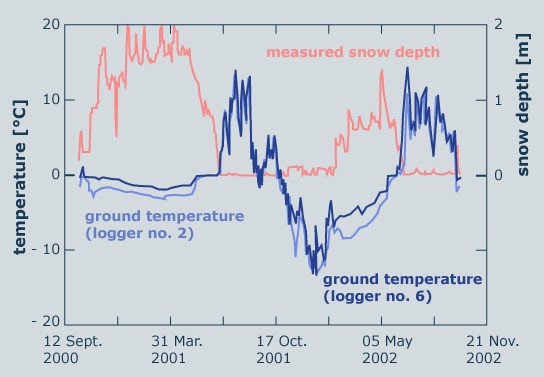 |
|
|
|
|
|
|
Ice rich permafrost occurrences are often in an unstable equilibrium. Even small changes in the surface conditions can have substantial and irreversible consequences. Therefore, it should be self-evident that man’s impact on the permafrost environment should be carefully evaluated. |
|
The importance of snow cover to ground thermal conditions is widely recognized. The influence of snow can be explained with reference to the pattern of seasonal temperature variation. Snow is an insulator compared to other natural materials, and is a leading factor in protecting the ground from heat loss in winter. The influence of snow cover on ground thermal regimes depends on the thickness, density and duration of the snow cover. Snow has a low heat transfer capacity. A sufficiently thick snow cover of around 1m, therefore, insulates the soil from short-term variations in atmospheric conditions. Furthermore, thermal conductivity heavily depends on the density of the snow cover. Snow with higher densities has a smaller damping effect on daily or seasonal surface temperature waves than snow with lower densities. A large accumulation of snow in early autumn inhibits freezing (cooling of the active layer), but a thick snow cover in spring will delay thawing. |
 1 - Ground temperature measurements in a mountain
permafrost area in Eastern Switzerland. The measurements show the close
relationship between ground temperatures and snow cover development. |
| The relationship between accumulation and ablation periods will determine the net effect of the snow cover on ground thermal regimes. In discontinuous mountain permafrost areas, where mean annual ground temperatures are generally close to 0°C, snow cover characteristics can be responsible for the local existence or absence of permafrost. In addition, permafrost itself reduces the heat flux at the base of the snow cover as compared to permafrost-free areas, because smaller amounts of heat are stored in the upper few meters below the surface during the summer. This leads to reduced heat flow towards the base of, and smaller temperature gradients within, the winter snow cover. |
 |
In the ablation area of glaciers, permafrost is warmed by melt water at the glacier bed and by the heat of friction. In contrast, cooling takes place in cold or polythermal accumulation areas by advective transport of cold ice from higher firn areas. Depending on previous ice temperature and the local climate glacier forefields can cool during glacier retreat. During a glacier's advance, the surface conditions can be changed markedly by the building of lakes, destruction of vegetation or sedimentation of frost susceptible material. With subglacial permafrost nearly no sliding at the glacier bed occurs. This very strongly influences the stability of hanging glaciers, the glacier discharge or outburst mechanisms of glacier lakes. |
|
2 - Glacier forefields that had been covered during the ‘Little Ice Age’ by temperate glaciers, today show signs of recently developed permafrost (64K) |
|
29 August 2011 |
||
| |
||